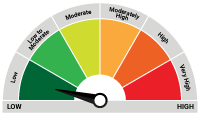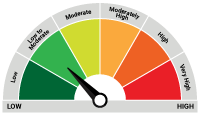Are Long Bonds Overvalued?
Posted On Friday, May 26, 2023
Indian bond market had a dream run in the last two and a half months. The 10-year Indian government bond (G-sec) yield fell by 50 basis points from 7.46% on February 28, 2023 to around 6.98% at the time of writing this report on May 18, 2023. The 10-year government bond yield is now below the levels prevailing at the start of the rate hiking cycle in May last year.
Chart – I: Long term bond yields have fallen below the first-rate hike levels

Source – Refinitiv, Quantum Research, Data as of May 18, 2023
Past Performance may or may not sustain in the future.
There have been series of favorable developments since March that led to sharp turn in investor sentiment in the bond market.
RBI’s surprise pause on rate hikes, not just moved the market expectation to an extended pause, but also led to speculation of rate cuts by the year end. The recent drop in CPI inflation below 5%, added more fuel to it.
The US monetary policy cycle is also expected to reverse as priced in the US treasury curve. Even after the partial reversal, the US treasury futures curve is still pricing for more than 50 basis points rate cut by the federal reserve in the current year.
The bond market also witnessed a sudden spurt in demand from local investors. Part of it can be attributed to the sharp jump in inflows in debt mutual funds and insurance companies during the last two weeks of March when investors rushed to invest before the favorable tax deadline on 31st March 2023. To recall, the government has removed the favorable tax treatment on debt mutual funds compared to bank fixed deposits and capped the insurance premium to Rs. 5 lakh per annum for tax exemption.
Will the trend continue?
After the sharp drop in yields, the valuation cushion in the long-term bonds is exhausted. The spread between the 10-year government bond and the repo rate has shrunk to 48 basis points from 94 basis points in February 2023. This is lowest level observed since 2017. Even during the 2019-2020 period when the repo rate was cut by 250 basis points, this spread was materially higher than current levels.
Typically, the spread between long term bond yields over the Repo rate narrows closer to a start of rate cutting cycle. At this stage, the probability of rate cut in 2023 looks very slim given the CPI inflation is still far from the RBI’s 4% goal. Thus, the valuation on the 10-year government bond trading below 7% looks stretched.
Furthermore, the demand supply dynamics looks unfavorable going forward. In the last two months, the demand-supply balance in the bond market was supported by - (1) frontloading of demand from Mutual funds and Insurance companies, (2) likely buying (based on media reports) from Russian exporters and demand from HDFC and HDFC bank merger, and (3) lower supply of State Government bonds than the indicative calendar.
We expect these one-off demands to fade away over the coming months. Overall, in the fiscal year 2023-24, we expect a net shortfall in natural demand for central and state government bonds of around Rs. 2.6 trillion. Thus, there would be a need for the RBI to buy bonds in the later half of the year, absence of which could push bond yields higher again.
Chart – II: Demand is expected to fall short of Supply by around Rs. ~2.6 trillion

Source – RBI, Budget Documents, Quantum Research
Going ahead, long term bonds will likely face pressure due to increasing net supply in Q2 and Q3 of FY24. While on the other hand, market condition for short term bonds have changed favorably with pause in rate hikes and easing liquidity condition.
Core liquidity (banking liquidity plus government cash balance) surplus has increased from ~Rs.800 billion in April 2023 to ~Rs. 1.2 trillion in May 2023(as per the latest available data for May 12, 2023) due to RBI forex purchases.
It will likely increase further due to – (1) RBI’s dividend payment to the government, and (2) deposit of Rs. 2000 note after the RBI’s announcement to withdraw it from circulation.
The RBI announced to transfer Rs. 874.16 billion as surplus to the Central Government for the accounting year 2022-23. This is much higher than the union budget estimate of an aggregate dividend of Rs. 480 billion from the RBI and public sector banks combined.
The higher RBI dividend will be marginally positive for the fiscal position while we don’t expect it to have any material impact on the government’s borrowing program. The other more significant impact of higher dividend will be seen on the liquidity condition. Given the upcoming bond maturity of around Rs. 1 trillion, the surplus amount is expected to be utilized (in bond repayment) sooner than later. This would add a significant durable liquidity in the banking system.
Another notable development from liquidity standpoint is the withdrawal of Rs. 2000 denomination currency notes. The total value of these banknotes in circulation of 31st March 2023, was Rs. 3.62 trillion. We believe a large portion of these notes will be exchanged for other denomination notes, which will have no impact on the system liquidity.
The liquidity condition will only be impacted (increased) by the deposit of these currency notes in the bank account. It is difficult to estimate the extent of deposits at this juncture. While our guess is it should be somewhere near Rs. 500 billion over the next 2-3 months.
Combination of above-mentioned factors along with cyclical decline in cash demand between June – August period should substantially ease the liquidity condition in coming months.
This should bring down money market rates and yields on short term bonds over the next 2-3 months.
Chart – III: Core Liquidity Increased due to RBI’s Forex purchases

Source- RBI, Quantum Research; Data upto May 12, 2023
All-in-all, we do not expect any meaningful decline in long term bond yields from current levels. However, short term bond yields should continue to drift lower. Thus, the yield curve will likely steepen going forward.
Chart – IV: Yield curve is expected to steepen again

Source – Refinitiv, Quantum Research, Data as of May 18, 2023
Past Performance may or may not sustain in future
At this stage, the 2-5 years maturity government bonds are attractively positioned with a medium-term outlook.
What should Investors do?
Though starting yield has come down from an earlier level, there is decent accrual still available at current levels.
Even in the real term (adjusted for inflation), government bonds are still offering meaningful positive real yield. With expected CPI inflation of 5.2% (RBI’s FY24 inflation estimate) and a 1-year Gsec yield at 6.85%, the real yield is around 165 basis points.
Chart – V: Attractive real yields available across the government bond yield curve.

Source – Refinitiv, Quantum Research, Data as of May 18, 2023
# Real rates are based on the RBI’s FY24 average CPI inflation estimate of 5.2%.
Past Performance may or may not sustain in future
Overall, the return potential of fixed-income funds is still better, and the next three years are likely to be more rewarding for fixed-income investors than what we witnessed in the last three years.
We suggest investors with 2-3 years holding period should consider adding their allocation to dynamic bond funds.
Dynamic bond funds have the flexibility to change the portfolio positioning as per the evolving market conditions. This makes dynamic bond funds better suited for long-term investors in this volatile macro environment than other long-term bond fund categories.
A Dynamic Bond Fund or any other debt fund which invests in long-term debt instruments is highly sensitive to interest rate movements. Thus, in a short period of time, returns could be highly volatile and can even be negative. However, over a longer time frame of over 2-3 years period, returns tend to normalize along with the interest rate cycles.
Investors with shorter investment horizons and low-risk appetites should stick with liquid funds. Tightening liquidity conditions will continue to put upward pressure on short-term rates and is, in turn, positive for short-term debt fund categories like the liquid fund. We would expect further improvement in the return potential of these categories as interest accrual on short-term debt instruments has risen meaningfully.
Since the interest rate on bank saving accounts are not likely to increase quickly while the returns from the liquid fund are already seeing an increase, investing in liquid funds looks more attractive for your surplus funds.
Chart – VI: Liquid Fund Yields Moved up Tracking Treasury Bill Rate; Gap between Liquid fund yield and saving bank interest rate widened further

Source – Refinitiv, Quantum Research; Data as of March 31, 2023
Past Performance may or may not sustain in future.
Investors with a short-term investment horizon and with little desire to take risks should invest in liquid funds which own government securities and do not invest in private sector companies which carry lower liquidity and higher risk of capital loss in case of default.
Portfolio Positioning
Scheme Name | Strategy |
The scheme continues to invest in debt securities of up to 91 days of maturity issued by the government and selected public sector companies. | |
The scheme continues to invest in debt securities issued by the government and selected public sector companies. The scheme follows an active duration management strategy and increases/decreases the portfolio’s sensitivity to interest rates in line with Interest Rate Outlook. With sharp fall in bond yields, we have tactically reduced the portfolio duration in the QDBF portfolio by selling long term bonds while remain invested in GOI FRB and 1-2 year Government and PSU bonds to maintain accrual. |
For any queries directly linked to the insights and data shared in the newsletter, please reach out to the author – Pankaj Pathak, Fund Manager – Fixed Income at [email protected].
For all other queries, please contact Neeraj Kotian – Area Manager, Quantum AMC at [email protected] / [email protected] or call him on Tel: 9833289034
Read our last few Debt Market Observer write-ups -
- The Pivot
- Yield Curve Inversion Ahead
Portfolio Information Scheme Name: Quantum Liquid Fund | |
| Description (if any) | |
Annualised Portfolio YTM*: | 6.88% |
Macaulay Duration | 25 days |
Residual Maturity | 25 days |
As on (Date) | 30-04-2023 |
*in case of semi annual YTM, it will be annualised
| Performance of the Scheme | Direct Plan | |||||
| Quantum Liquid Fund - Direct Plan - Growth Option | ||||||
| Current Value ₹10,000 Invested at the beginning of a given period | ||||||
| Period | Scheme Returns (%) | Tier 1 - Benchmark# Returns (%) | Additional Benchmark Returns (%)## | Scheme Returns(₹) | Tier 1 - Benchmark# Returns (₹) | Additional Benchmark Returns (₹)## |
| Since Inception (07th Apr 2006) | 6.74% | 6.78% | 6.09% | 30,446 | 30,673 | 27,425 |
| April 30, 2013 to April 30, 2023 (10 years)** | 6.18% | 6.62% | 6.28% | 18,221 | 19,000 | 18,401 |
| April 30, 2020 to April 30, 2023 (3 years)** | 5.26% | 5.71% | 5.83% | 14,321 | 14,758 | 14,868 |
| April 30, 2022 to April 30, 2023 (1 year)** | 4.87% | 5.27% | 5.60% | 12,683 | 12,931 | 13,136 |
| March 31, 2023 to April 30, 2023 (1 month)* | 4.07% | 4.41% | 4.13% | 11,271 | 11,382 | 11,291 |
| April 15, 2023 to April 30, 2023 (15 days)* | 5.75% | 6.05% | 5.02% | 10,575 | 10,605 | 10,502 |
| April 23, 2023 to April 30, 2023 (7 days)* | 6.69% | 7.06% | 9.08% | 10,055 | 10,058 | 10,075 |
| April 23, 2023 to April 30, 2023 (7 days)* | 6.24% | 6.49% | 6.73% | 10,026 | 10,027 | 10,028 |
| April 23, 2023 to April 30, 2023 (7 days)* | 6.34% | 6.37% | 8.41% | 10,012 | 10,012 | 10,016 |
#CRISIL Liquid Fund AI Index, ##CRISIL 1 year T-bill Index.
Past performance may or may not be sustained in the future.
Different Plans shall have a different expense structure.
*Simple Annualized.
**Returns for 1 year and above period are calculated on the basis of Compounded Annualized Growth Rate (CAGR).
Returns are net of total expenses.
The Scheme is managed by Mr. Pankaj Pathak. Click here for performance details of other funds managed by him.
| Performance of the Scheme | Direct Plan | |||||
| Quantum Dynamic Bond Fund - Direct Plan - Growth Option | ||||||
| Current Value ₹10,000 Invested at the beginning of a given period | ||||||
| Period | Scheme Returns (%) | Tier 1 - Benchmark# Returns (%) | Additional Benchmark Returns (%)## | Scheme Returns (₹) | Tier 1 - Benchmark# Returns (₹) | Additional Benchmark Returns (₹)## |
| Since Inception (19th May 2015) | 7.77% | 7.64% | 6.25% | 18,136 | 17,959 | 16,197 |
| April 29, 2016 to April 28, 2023 (7 years) | 7.47% | 7.43% | 5.89% | 16,561 | 16,520 | 14,932 |
| April 27, 2018 to April 28, 2023 (5 years) | 7.21% | 7.76% | 6.59% | 14,169 | 14,537 | 13,762 |
| April 30, 2020 to April 28, 2023 (3 years) | 5.01% | 5.48% | 3.08% | 11,577 | 11,732 | 10,952 |
| April 29, 2022 to April 28, 2023 (1 year) | 6.79% | 6.03% | 7.03% | 10,677 | 10,602 | 10,701 |
#CRISIL Dynamic Bond Fund AIII-Index, ##CRISIL 10 Year Gilt Index.
Past performance may or may not be sustained in the future.
Different Plans shall have a different expense structure.
Returns are net of total expenses and are calculated on the basis of Compounded Annualized Growth Rate (CAGR).
The Scheme is managed by Mr. Pankaj Pathak. Click here for performance details of other funds managed by him.
Name of the Scheme | This product is suitable for investors who are seeking* | Riskometer |
Quantum Liquid Fund An Open-ended Liquid Scheme. A relatively low interest rate risk and relatively low credit risk. |
|  Investors understand that their principal will be at Low Risk |
Quantum Dynamic Bond Fund An Open-ended Dynamic Debt Scheme Investing Across Duration. A relatively high interest rate risk and relatively low credit risk. |
|  Investors understand that their principal will be at Low to Moderate Risk |
* Investors should consult their financial advisers if in doubt about whether the product is suitable for them.
| Potential Risk Class Matrix – Quantum Dynamic Bond Fund | |||
Credit Risk → | Relatively Low | Moderate (Class B) | Relatively High (Class C) |
Interest Rate Risk↓ | |||
Relatively Low (Class I) | |||
| Moderate (Class II) | |||
| Relatively High (Class III) | A-III | ||
| Potential Risk Class Matrix – Quantum Liquid Fund | |||
Credit Risk → | Relatively Low | Moderate (Class B) | Relatively High (Class C) |
Interest Rate Risk↓ | |||
| Relatively Low (Class I) | A-I | ||
| Moderate (Class II) | |||
| Relatively High (Class III) | |||
Disclaimer, Statutory Details & Risk Factors:The views expressed here in this article / video are for general information and reading purpose only and do not constitute any guidelines and recommendations on any course of action to be followed by the reader. Quantum AMC / Quantum Mutual Fund is not guaranteeing / offering / communicating any indicative yield on investments made in the scheme(s). The views are not meant to serve as a professional guide / investment advice / intended to be an offer or solicitation for the purchase or sale of any financial product or instrument or mutual fund units for the reader. The article has been prepared on the basis of publicly available information, internally developed data and other sources believed to be reliable. Whilst no action has been solicited based upon the information provided herein, due care has been taken to ensure that the facts are accurate and views given are fair and reasonable as on date. Readers of this article should rely on information/data arising out of their own investigations and advised to seek independent professional advice and arrive at an informed decision before making any investments. Mutual fund investments are subject to market risks read all scheme related documents carefully. |
Related Posts
-

The Pivot
Posted On Friday, Apr 21, 2023
The fiscal year 2022-23 has come to an end. The defining feature
Read More -

Yield Curve Inversion Ahead
Posted On Thursday, Mar 23, 2023
Indian money markets have tightened meaningfully over the last one and a half month.
Read More -

Past, Present, and Future of Inflation
Posted On Friday, Feb 24, 2023
Inflation has been one of the biggest challenges in the post-pandemic world.
Read More




